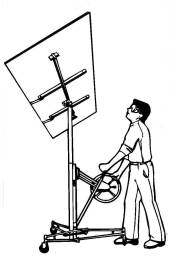Get the Hang of Drywall |
|
| Hanging drywall, or
wall board, can go smoothly and simply—without hiring it out—if
you're a moderately skilled do-it-yourselfer armed with the right
knowledge and the right tools.
The first step is to estimate the amount of material you need. Measure the square footage of the walls and ceiling and note the placement and size of windows and doorways. Then head to your lumber yard to select your drywall and get help determining the number of sheets you'll use. Keep in mind, you have to account for waste that gets cut off and can't be used. Waste typically adds 15% to your basic square feet total. Sheets come in various thicknesses (1/2" is probably the most common) and lengths (up to 16'). Sheets are typically 4' wide. The longer the sheet you can handle the better, because that means fewer seams. But drywall is very heavy, so, if you can, have someone around to help, and count on renting a drywall jack for lifting and holding each sheet in place on the ceiling while you anchor it. Cutting drywall is easy. First make your measurement, mark the sheet with a chalk line and score the paper with a sharp utility knife along the mark. Score along a metal straight edge or the factory edge of another piece of drywall. Then stand the sheet upright horizontally, hold on both sides of the cut and rap the back side of the sheet with your knee, snapping the board along the score. Finish the cut by scoring the paper on the back side. Be sure to cut out for outlets, switches, light fixtures and the like before fastening to the wall. |
You can use nails or screws to fasten drywall to studs. Most professionals now use screws. Rent an electric screw gun to do the job. The trick is to set the screw head just below the surface of the drywall. Too deep and you'll crush the drywall and weaken the holding power. Plus, the more dents and dings you create, the more work you'll have masking them later. Hang ceiling sheets first, before walls. A drywall jack is nearly essential for this job, as is another set of hands. Butt sheets up tight, but don't worry about small gaps because you can cover them later. When installing drywall on a ceiling, go ahead and use your head to help press the sheet to the ceiling as you nail or screw. But wear a hat with a sponge underneath to cushion the blow. Once all the drywall is hung, the joints must be taped with drywall tape, and drywall compound, or mud, must be applied. Ask for specific application tips where you purchase it, but the general principle is to disguise all joints and seams by smoothing and feathering the mud, and sanding when dry. Be sure to stop by for your drywall tools and ask us for advice. |
 |
|